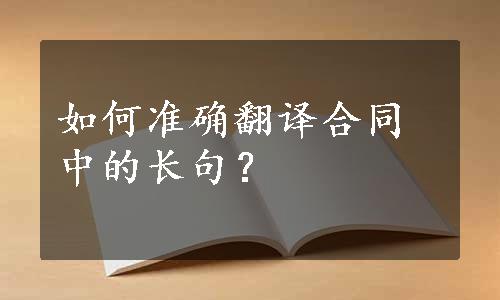
与普通英语相比较而言,商务合同英语中的句子结构就其长度和使用从句的连续性要复杂得多。分析合同长句的基本方法是:首先,要找出全句的主语、谓语和宾语,即句子的主干结构;其次,要找出句子中所有的谓语结构、非谓语结构、介词短语和从句的引导词,然后再分析从句和短句的功能,即是否是主语从句、宾语从句、表语从句或状语从句等,以及词、短语和从句之间的关系;最后,分析句子中是否有固定搭配、插入语等其他成分。
(1)The Buyer may,within 15 days after arrival of the goods at the destination,lodge a claim against the Seller for short-weight being supported by Inspection Certificate issued by a reputable public surveyor.(货物抵达目的港15天内,买方可以凭有信誉的公共检验员出示的检验证明向卖方提出短重索赔。)
这是一个简单长句,其主干为The Buyer may…lodge a claim…。修饰谓语动词的状语有三个,分别表示时间(within 15 days after arrival of the goods at the destination)、方式(being supported by Inspection Certificate issued by a reputable public surveyor)和原因(for short-weight)。诸多状语尽管在原文中位置灵活,然而在译文里,须按照汉语的行文规范适当进行调整:方式状语一般应置于动词之前;其他状语可以灵活处理,如本句中的时间状语可以提前至句首。再如:
(2)If a Party breaches any of the representations or warranties given by it in Articles 18.1 or repeated in 18.2,then in addition to any other remedies available to the other Party under this contract or under Applicable Laws,it shall indemnify and keep indemnified the other Party and the company against any losses,damages,costs,expenses,liabilities and claims that such Party or the Company may suffer as a result of such breach.(如果一方违反任何其根据第18.1条或18.2条所做的陈述及担保或重述,则另一方除根据本合同或相关法律寻求任何可能的救济之外,违约方应当赔偿另一方或合营公司由此造成的任何损失、损害、费用、开支、责任或索赔。)
本句的主干是it shall indemnify and keep indemnified...against...the other Party and the company。if引导的是条件从句,条件句的宾语部分跟随后置定语(given by it in Articles 18.1 or repeated in 18.2)。in addition to 引导的是增补成分,其核心词remedies也跟了后置定语(available to the other Party under this contract or under Applicable Laws)。that引导的则是后置定语修饰紧邻的五个名词。基于以上分析,再结合汉语的行文习惯(条件在前,结果在后以及定语在所修饰的核心词之前),即可翻译成文。(www.zuozong.com)
(3)The Seller shall not be responsible for the delay of shipment or non delivery of the goods due to Force Majeure,which might occur during the process of manufacturing or in the course of loading or transit.(凡在制造或装船运输过程中,因不可抗力致使卖方不能或推迟交货时,卖方不负责任。)
上句中信息的重心在句首,先表明卖方的免责事项,接着再规定由于什么原因引起的不能交货或延迟交货才会免责,后对不可抗力又做了限定。按照汉语的思维习惯,往往先谈原因,再讲结论,因此采用颠倒顺序的译法更合理。
综上,在翻译合同长句的时候,不管属于何种类型,译者都可在对原句进行分析的基础上,根据汉语行文习惯,适当变换修饰成分的顺序,是有可能准确翻译原文的。
免责声明:以上内容源自网络,版权归原作者所有,如有侵犯您的原创版权请告知,我们将尽快删除相关内容。




